The Lite2Sound Story
by Eric Archer
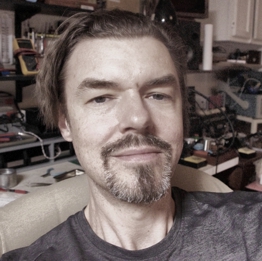
Hello! I’ve been interested in analog electronics, music, and audio since the 1980s. My work has led me to design electronic circuits that let you hear light. I call these devices Lite2Sound. The story below timelines the path I’ve followed while finding ways to listen to the lights.
Around 1990, while I was in high school, my 9th grade science teacher noticed that I was always ahead of the class lessons and gave me extra opportunities to learn about science beyond the textbooks. He opened a door in the back of the classroom and showed me into the science department stock room where the lecture demo supplies were kept. He told me to have a look around and try to figure out how the gizmos and stuff worked. That’s where I spent most science class periods that year. The stock room had high shelves stacked with physics and chemistry things. I found a HeNe laser, and with it was a black box that had a speaker and some sort of analog sensor. You could shine the laser beam at a sensor on the box and hear sounds coming from it. I remember holding a glass microscope slide so the laser beam passed through it. The speaker was making funny high pitched noises like soapy fingers squeaking on glass or DJ scratches. The sounds were traveling through a light beam.
When I was young I collected DIY electronics books and often assembled circuits published by authors like Forrest Mims III. One of his circuits was titled Infrared Voice Communicator. It was a modern derivative of Alexander Bell’s 19th-century photophone, using an IR LED and a silicon phototransistor.
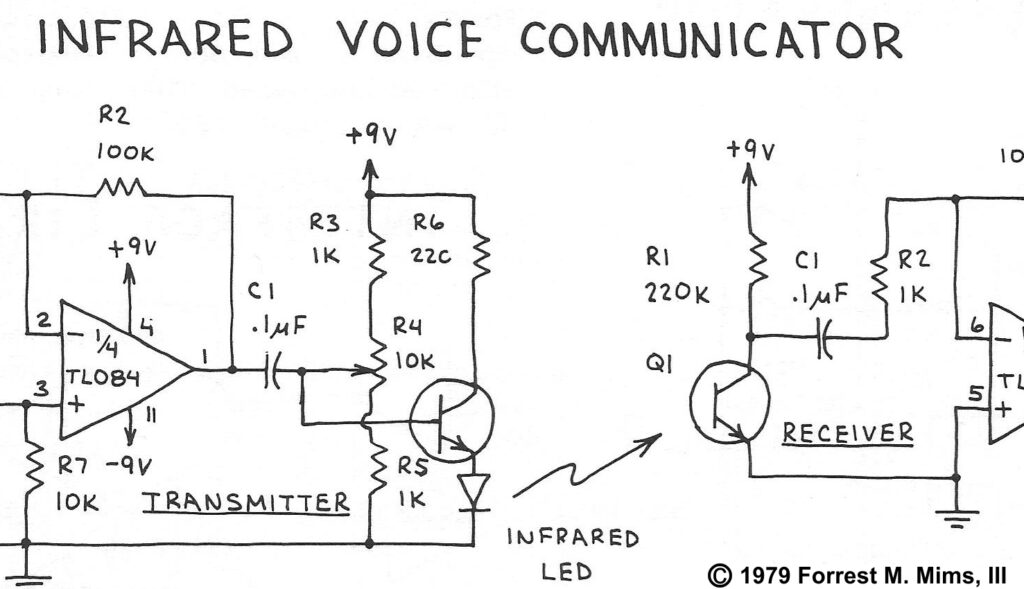
I assembled the circuit and found it worked, though there was nothing amazing about wireless voice communications because radio walkie-talkies were common in the 90s and they did that trick much better. On the other hand, while experimenting I noticed that the receiver half of Infrared Voice Communicator picked up sounds even while its transmitter was off. With it I could hear humming and buzzing tones from light bulbs, LED alarm clocks, remote controls and television screens. It turned out that besides hearing your assistant speaking on a beam of light, there were other background sounds coming in from the ether.
This brings up a distinction between engineers and musicians. An engineer would call those sounds unwanted signals, and state that the Infrared Voice Communicator’s usefulness is limited by its vulnerablility to interference. But a musician hearing these sounds may come to the opposite conclusion. Some of the unwanted signals can have interesting harmonic and rhythmic qualities – maybe thats the sort of stuff I’d rather listen to instead of a jabbering telephone.
So that’s how I realized that many ordinary lights make inaudible sounds and all you need is a basic circuit to hear them.
Much later on around 2007, I remembered listening to lights through a phototransistor and returned to that subject. Since technology always advances, there are always new types of lights, and there ought to be new sounds along with them. Maybe no one has heard it yet? In fact its not hard to tune in with simple electronics.
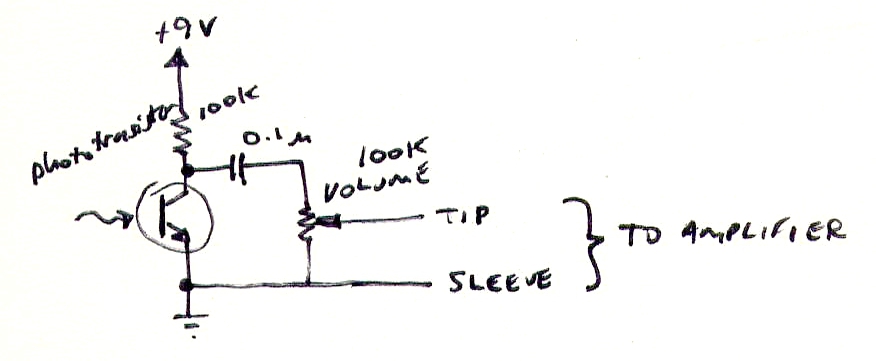
I found that just a phototransistor, resistor, capacitor and battery can be put together for an easy modulated light receiver. I plugged it into a guitar amp to hear it. The guitar amplifier gives plenty of gain to amplify the phototransistor’s voltage output, so it was fairly sensitive. But it was also noisy, distorted, and the tone quality was not ideal because of the guitar amp’s equalization contour. Some way to boost the audio quality was clearly necessary. At that point I stopped using phototransistors and worked with photodiodes instead.
In 2008 I began offering a basic photodiode audio receiver in DIY kit form. This was the first version of Lite2Sound. I started selling these in May 2009, and about 30 of them total were sold. The original Lite2Sound was powered by two CR2032 coin cells, and its sensor was a 1 mm2 silicon PIN photodiode.

Exploring around the home and office with one, you could hear a lot of detail clearly and interesting audio textures from electronic displays and lights. I published some videos using it to listen to a phonograph record by reflecting a laser pointer off of the spinning vinyl.
However, the original Lite2Sound didn’t include automatic gain control so you had to mind the brightness level of the light source it was monitoring or the audio would cut out whenever the preamp overloaded. And it lacked a headphones output so it wasn’t really portable. In 2009 I made newer prototypes that added these features. I designed a DIY kit called Super Lite2Sound and pitched it to Make: Magazine’s Maker Shed store. Make didn’t go for it.
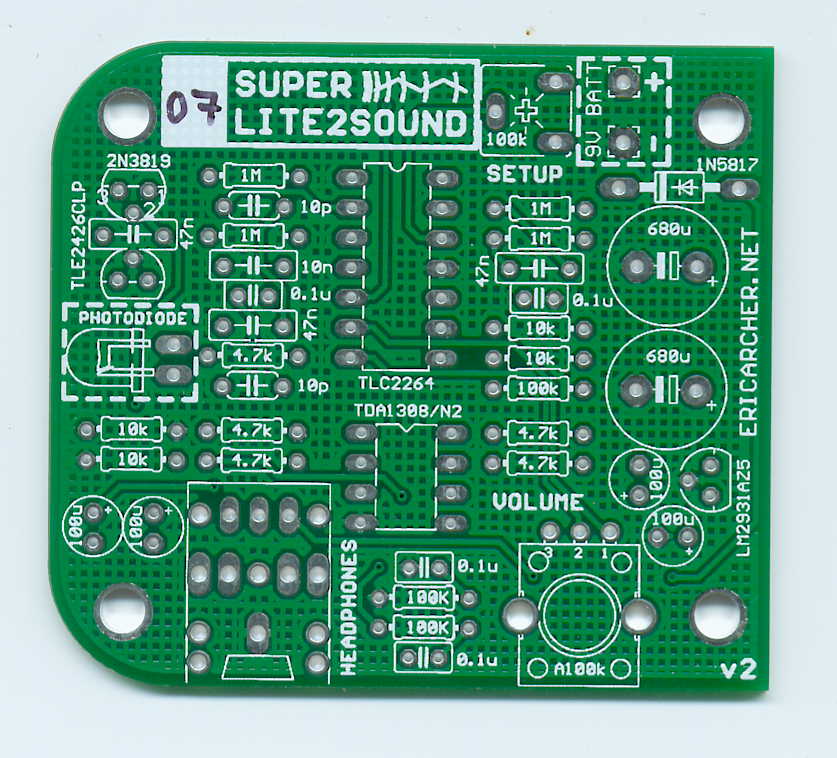
In 2008, I realized that the photodiode’s effectiveness improves if we increase the amount of light that it gathers using a camera lens. I built several photodiode amplifier devices inside of junk 8mm movie cameras. I removed their film shutters and then mounted a photodiode behind the lens where the film would have been.

Adding a camera’s optical lens makes a photodiode’s pickup pattern much more directional. Now it reached into the night, blending a multitude of city lights together into an audio mix. It was fascinating to hear nighttime cityscapes with a photodiode. I hunted for interesting audio by pointing it out the windows of moving vehicles. The variety of sounds that came through the headphones was surprising.
In this period, I called the photodiode amplifier – camera lens hybrid a “Sound Camera”. I mounted a DVD camcorder onto the modified 8mm film camera with both lenses aimed in parallel. I then patched the audio out of the photodiode into the camcorder’s microphone input. This setup allowed video recording with a synchronized audio soundtrack generated by the ambient modulated lights in the scene.
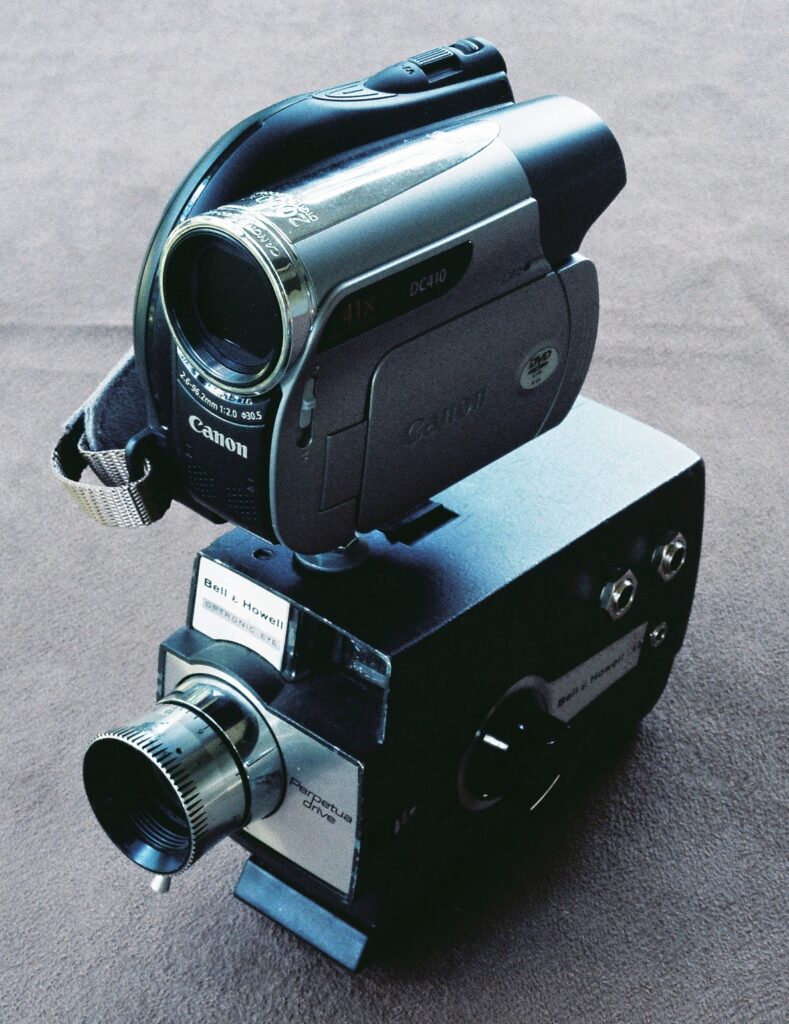
I made my first video field recording of a cityscape with this technique in 2008 while traveling by car in New York City at night (Vimeo link). This got about 10,000 views on Vimeo. An editor of the German filmmakers’ magazine Schmalfilm noticed my offbeat use of 8mm and contacted me. I was honored when Schmalfilm mentioned my Sound Camera device in an editorial on the last page of their magazine’s last print edition, dated 6/2008.
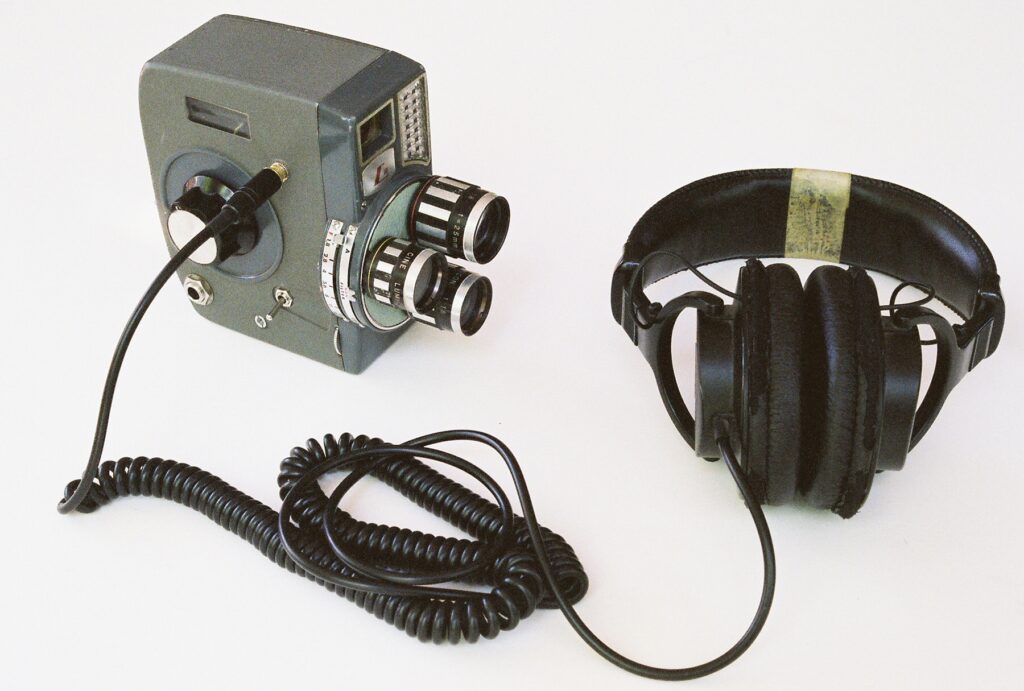
I looked all over for sounds contained in light. One afternoon by chance I recorded a weird clip of audio while pointing the Sound Camera toward the sun. At the time it sounded like a human voice uttering humming or speech in clipped intermittent phrases. I pondered what kinds of modulated light signals might come from outside earth’s atmosphere… although years passed before I understood that the unearthly sound was actually insects passing overhead! Their wingbeats had modulated the sunlight by occlusion as it shone on the photodiode. But could one ever possibly hear modulated light from an actual astronomical source, like a pulsar?
I still wanted to know what pure sunlight sounds like. When I listened with a Lite2Sound to sunlight passing through clear air, or a spot of sunlight gleaming from polished metal, I often heard a rustling noise sound. This is from the turbulent air in the atmosphere – it illustrates that daytime sunlight flickers like starlight although our eyes can’t perceive it.
With so many artificial lights in the world, audio frequency modulated light is commonplace. Its sources are arranged in varying patterns and moving kinetically around us. But its sounds are emitted in a layer of reality that no one normally tunes in to. Could there be certain moments at specific locations where these hidden sounds rise above randomness and blend together into something that touches the listener? Aren’t sounds but only sound until someone hears them as music? Therefore there should be a receiver to pick up this medium – so there may be more music in the world.
With that in mind, in 2009 I built several prototypes that were pocket sized and had headphones output. I used re-purposed containers including film cans and the popular Altoids tin.
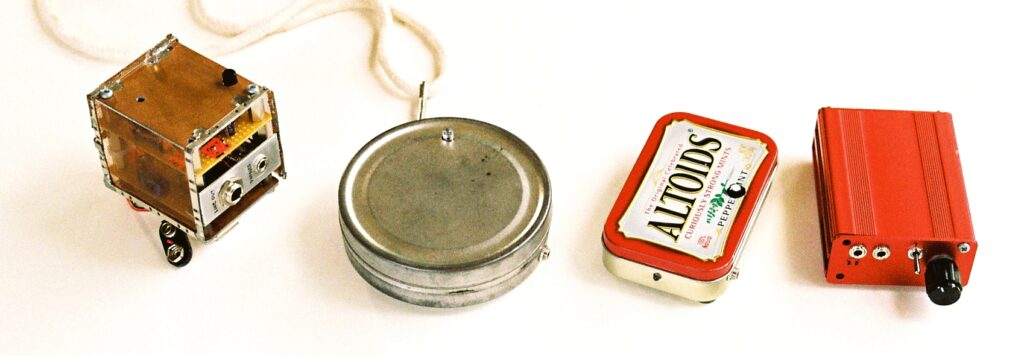

In 2010 I built the first stereophonic Lite2Sound device. Using it outdoors in daylight I uncovered an interesting phenomenon involving sunlight modulated by reflection from a body of water. The audio I heard from the water made powerful sci-fi laser zap sound effects in stereo. I made these sound files available on my website and received positive messages from others who wanted to understand how it was taking place. But I had no idea! It was a fun mystery to comprehend how such out-of-the-ordinary sounds could come from the surface of water.
In 2012 Hans Kristian Senneseth asked me to create a project for a DIY class he would lead at the Piksel [X] festival in Bergen, Norway. For this I developed Lite2Sound PX, and it has remained in production ever since. It has both automatic gain control (AGC) and a headphones output. Its simple to use since its only adjustment is a volume slider.

Other Lite2Sound PX workshops followed. In 2013, a DIY workshop at 3rd Ward Brooklyn was organized in which the class built these devices. In 2017, Mark Cetilia’s class at RISD also built them.
As it turned out though, I hadn’t heard any feedback from the workshop students. It felt like sending my work out into a void. Regardless, there were already hundreds of Lite2Sound PX users in the world and I had received positive messages from the few who wrote back explaining how they were using it. I learned that professional sound designers had been making clever use of it behind the scenes. Other sound artists were employing it as a pickup to extract harmonic timbres from optical tonewheels. The Noise Jockey blog posted positively about it in 2014 (web link).
I wanted to move Lite2Sound past bare circuit boards and recycled housings. I wanted it to be more convenient with the option to listen on a built in speaker. In 2017, I began offering Lite2Sound QB. It originally was monophonic. It has a built in speaker as well as the sensor and battery inside a cube shaped wood case.
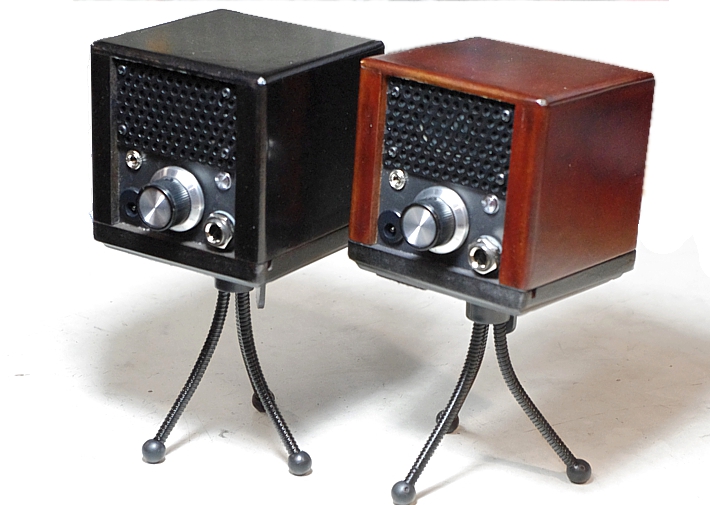
In 2018, Boldport Club asked me for a Lite2Sound circuit project they could offer to their DIY subscribers. I worked together with Ben Barwise to put out their Lite2Sound BC device (web link). This project soon became the subject of several Youtube videos featuring audio experiments by Boldport Club DIY makers.
In 2021 I revised Lite2Sound QB into a stereo device, incorporating the concept of two photodiodes angled slightly apart to provide a stereo audio image. I had begun using a CNC router for fabrication and I’d also added sheet metal capability in my shop.
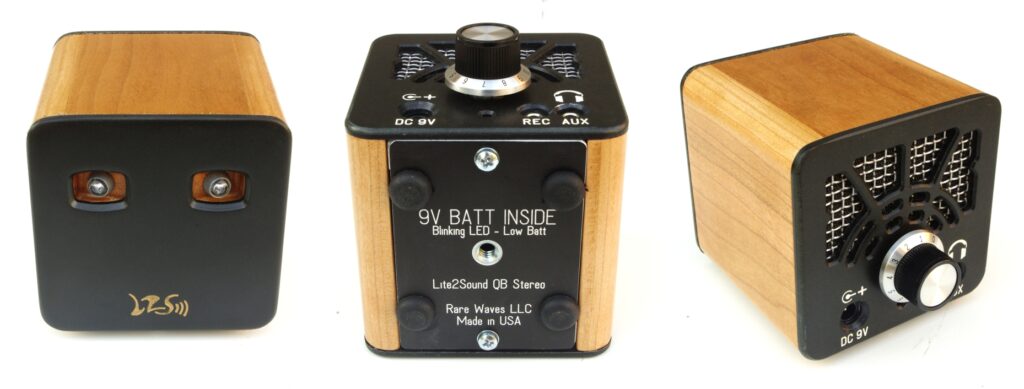
Lite2Sound QB Stereo is intended for convenient field recording. In 2021 I brought one to San Antonio and made recordings inside the dazzling Lightscape installation at the SA Botanical Gardens (Youtube link). This was also the first time I captured stereo sounds from a photodiode amplifier while driving on the highway at night (Youtube link).
In 2021 I experimented with optical lenses and larger sized photodiodes for better sound quality with less noise. I developed Lite2Sound EP on that theme. These are pocket sized monophonic units with thumbwheel volume control and headphone output. Lite2Sound EP can receive clean sounds from further away subjects than any of the previous Lite2Sound models.

On the topic of lenses: a few years previously, I had encountered an auto wreck where a vehicle slid off an icy road and crashed through a fence. In the debris I found a pair of headlamps that had broken off. These contained interesting dome-like glass lenses. I collected them and they gathered dust for a few years, but eventually I decided to find out how they performed as optical augmentation for photodiodes. After sawing the lamps open to separate the parts, I built a pair of new Lite2Sound devices around them.
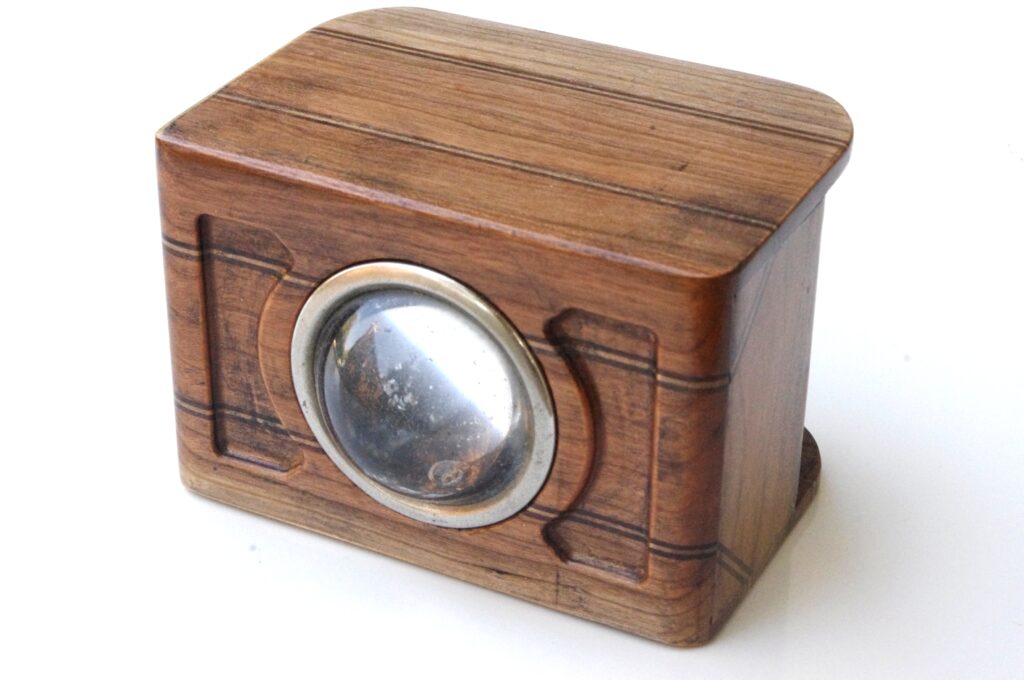
These captured stereo sound through a single lens for the first time. I used them for field recording cityscapes and traffic in Austin in 2022 (Youtube link) and Dallas in 2023 (Youtube link). The new devices performed well enough that while standing on a sidewalk, I could scan the sound of a tall building’s lights from street level to rooftop with clean sound. The circuit noise had been pushed lower than before. I could sense the beauty of serendipity in the clean audio I heard while pointing it toward ordinary things.
In 2023, a friend and Lite2Sound user visited New York City, taking one of these devices along with her to go out at night to make field recordings (Youtube playlist). She studied the NY cityscape, waterfront, and traffic. In her videos, wherever you look there is a layer of electronic tones and clicks in subtle patterns. Pointing the camera toward a distant thoroughfare, we hear a rumbling turbulence of hot air swirling from lines of cars while dozens of oscillator-driven headlights mix together like a traffic symphony.
In 2023 I was honored when Lite2Sound PX was mentioned in a behind the scenes video by sound designer Marshall McGee (Youtube link). He demonstrated some of his creative methods in the studio using falling water as a medium to make unusual sounds with Lite2Sound PX. The exposure sparked an increase in interest from the sound design community. It pushed me to develop Lite2Sound PX2 as the basic model for those who wish to experiment with a photodiode amplifier without having to put together a DIY kit.
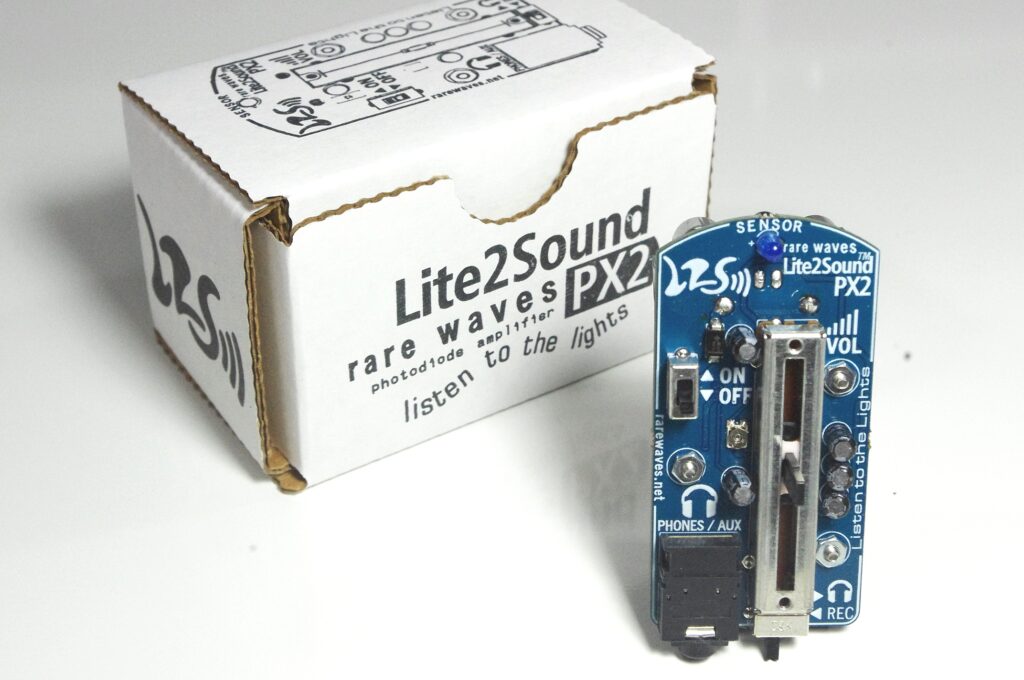
But I still wanted better sound quality in my field recordings – there can never be too little circuit noise. In late 2023 I continued developing large aperture stereo Lite2Sound devices. I revised the basic Lite2Sound circuit by developing a new kind of transimpedance amplifier that uses a balanced input to erase more of the circuit’s self-noise. A large lens concentrates ambient light onto the sensor.
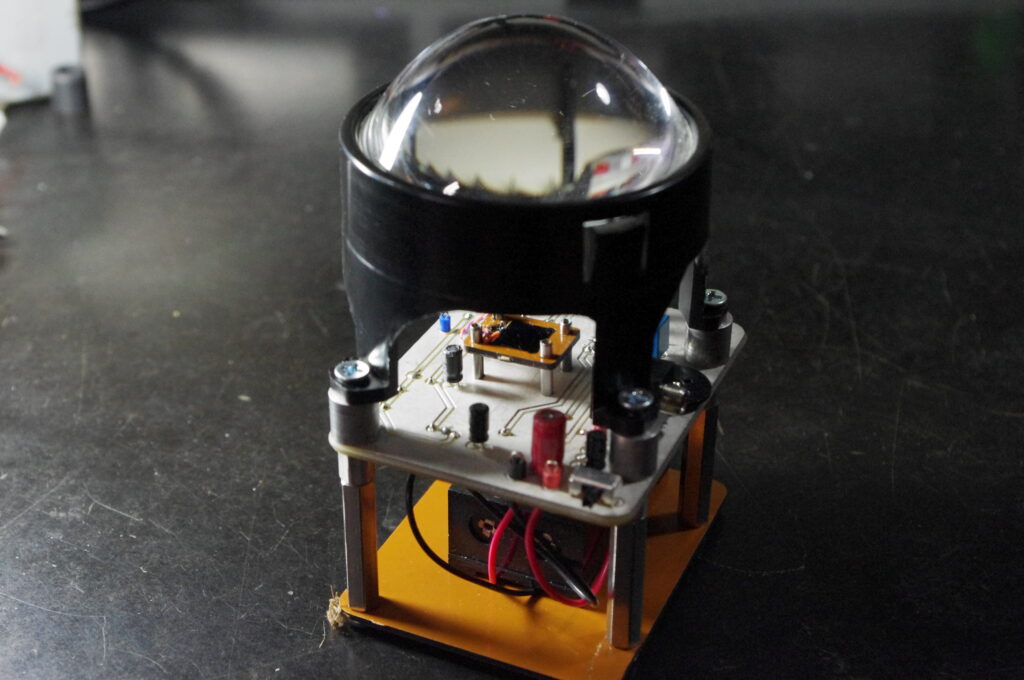
The signal to noise ratio had improved noticeably, thus these devices are incredibly sensitive. With this setup I heard the sound of starlight twinkling at night for the first time. In the night sky I could hear the grid hum of urban light pollution emitted by a metro area 30 miles away.
In early 2024 I assembled four new higher performance devices designated Lite2Sound HD Stereo. These units use a pair of large photodiodes behind a large optical lens. In comparison to the original Lite2Sound PX, these devices have 200 times greater sensor area and more nuanced analog circuitry. Together this gives a significant improvement in sound quality when making field recordings of cityscapes and traffic at night. The field of view of the sensor is also much wider than before. To house the new circuit, I created CNC machined padauk wood enclosures with custom fitted cigar-box style protective carrying cases for them.
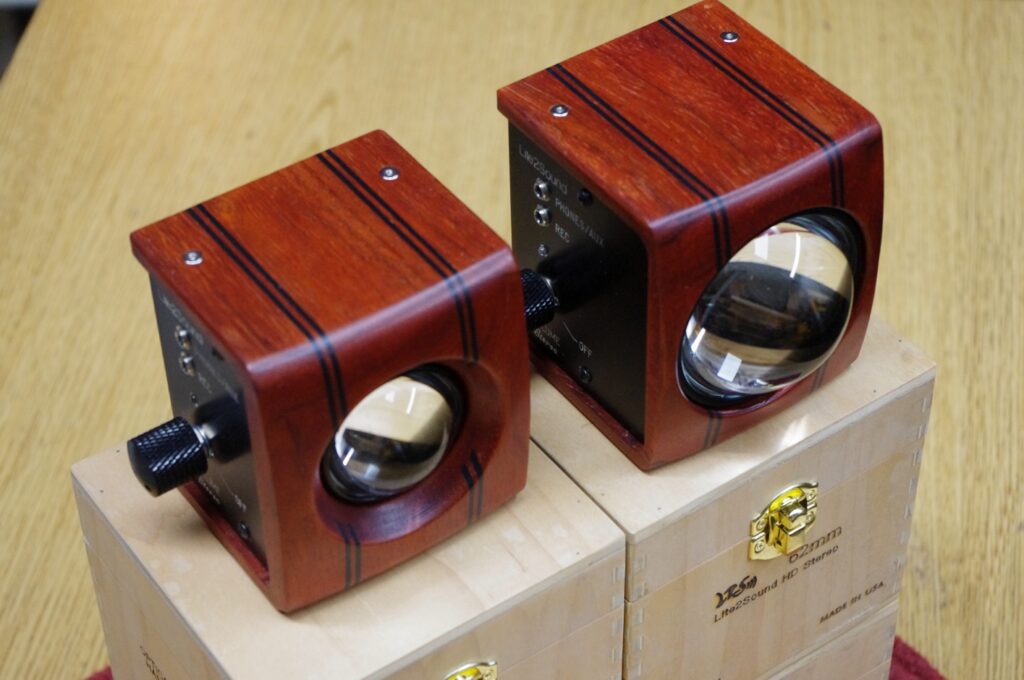
While this story has not ended, I bring your attention back to its beginnings: I believe it is important to encourage young people to follow their own path and invent things, even if it means a putting up with messy quarters, heaps of wires and junk-filled boxes.
